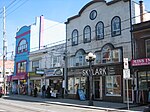Ashbridge Estate

The Ashbridge Estate is a historic estate in eastern Toronto, Ontario, Canada. The property was settled by the Ashbridge family, who were English Quakers who left Pennsylvania after the American Revolutionary War. In 1796, as United Empire Loyalists, the family were granted 600 acres (240 ha) of land on Lake Ontario east of the Don River, land which they had begun clearing two years earlier. The family constructed log cabins and frame homes on the shore of a bay, which was later named for them. The present home was built starting in 1854, with additions in 1900 and 1920. As the city of Toronto grew and encroached on the estate, the family gradually sold off their land, leaving only the current 2-acre (0.81 ha) property by the 1920s. The estate is located on Queen Street East near Greenwood Avenue in the Leslieville neighbourhood. In 1972, the family donated the estate to the Ontario Heritage Trust, although members of the family continued living in the home until 1997. The site was listed on the Canadian Register of Historic Places in 2008. The Ashbridges are the only family in the history of Toronto to have continuously occupied land that they settled for more than 200 years.
Excerpt from the Wikipedia article Ashbridge Estate (License: CC BY-SA 3.0, Authors, Images).Ashbridge Estate
Queen Street East, Toronto
Geographical coordinates (GPS) Address Nearby Places Show on map
Geographical coordinates (GPS)
| Latitude | Longitude |
|---|---|
| N 43.665303 ° | E -79.322759 ° |
Address
Queen Street East 1444
M4L 1E2 Toronto
Ontario, Canada
Open on Google Maps










